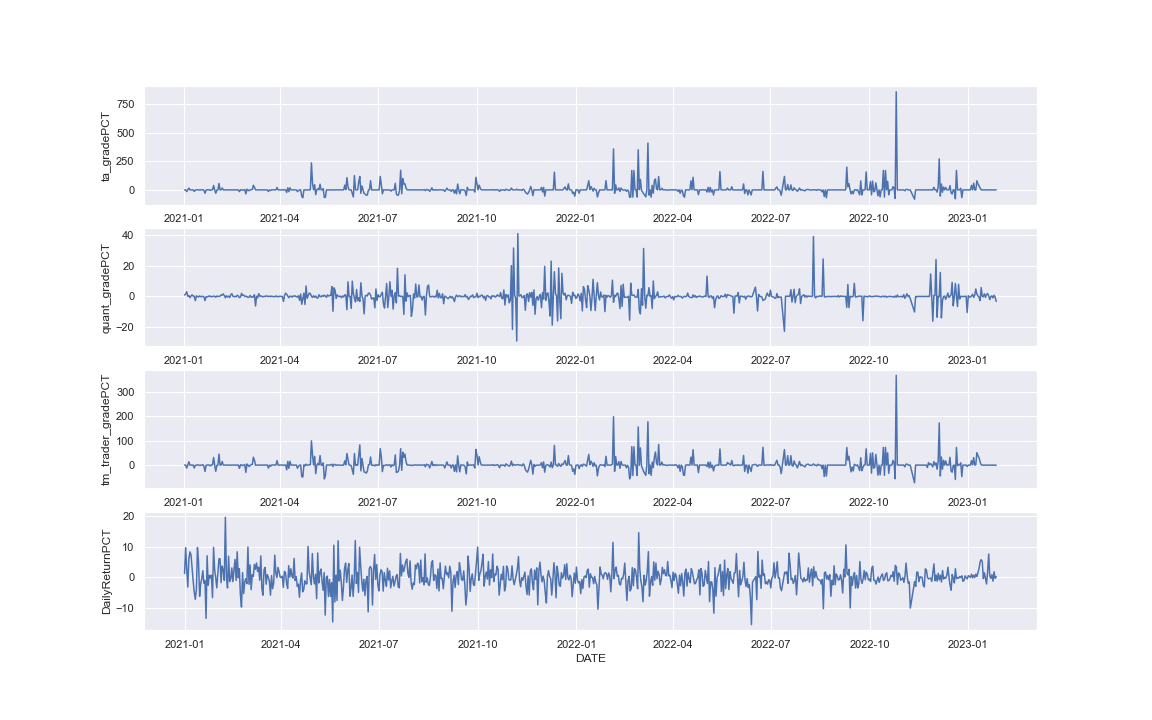Step 2 - Quantitative Analysis
Once we have the data, what will we do next?
Come up with an idea to serve as the backbone to a trading strategy!
2.1 Preparation Before the Action
Here are some packages and functions we will need later:
import matplotlib.pyplot as plt
import seaborn as sns
import numpy as np
import pandas as pd
from typing import Dict, List, Union, Optional, Any
import warnings
warnings.filterwarnings("ignore")
def plot_regressions(X, y, plots_in_col = 3, lowess=False):
labels = list(X.columns)
N, p = X.shape
rows = int(np.ceil(p/plots_in_col))
fig, axes = plt.subplots(rows, plots_in_col, figsize=(12, rows*(12/4)))
for i, ax in enumerate(fig.axes):
if i < p:
sns.regplot(X.iloc[:,i], y, ci=None, y_jitter=0.05,
scatter_kws={'s': 25, 'alpha':.8}, ax=ax, lowess=lowess,
line_kws={"color": "#c02c38"})
ax.set_xlabel('')
ax.set_ylabel('')
ax.set_title(labels[i])
else:
fig.delaxes(ax)
sns.despine()
plt.tight_layout()
plt.show()
return fig, axes
def plot_multiTS(data: pd.DataFrame, cols_idx: List, date_col: str):
sns.set_theme(style="darkgrid")
# cols_idx = [0, 1,3,4]
features = (len(cols_idx),1)
date = date_col
fig, axes = plt.subplots(features[0], features[1], figsize=(features[0]*4,10))
# data.date = pd.to_datetime(data.date)
for i in range(features[0]):
sns.lineplot(x = date,y = data.columns[cols_idx[i]], data = data,ax = axes[i,])
return fig
Next, we will read the data from the previous part.
data = pd.read_csv('../Data/btc_tg.csv', parse_dates=['DATE'])
2.2 Correlation Analysis
First, we should take a look at the relationship between those features.
fig = plot_multiTS(data[['TA_GRADE','QUANT_GRADE','TM_TRADER_GRADE','DailyReturnPCT','DATE']], list(range(4)), 'DATE')

From the plots above, we can observe the relationship:
- Both the
TM_TRADER_GRADEand theTA_GRADEhave similar features. - There seems to be a high relationship between the
TA_GRADEand theDailyReturnPCT. For example, when we were looking at the high volatility part of theDailyReturnPCT, it is clear that bothTM_TRADER_GRADEandTA_GRADEwere encountering volatility as well. QUANT_GRADEcontributes little to theDailyReturnPCT.
Let's move further, doing some transformation and statistics.
fig = plot_multiTS(data[['ta_gradePCT','quant_gradePCT','tm_trader_gradePCT','DailyReturnPCT','DATE']], list(range(4)), 'DATE')

Now, let's do simple linear regression to verify this relationship.
fig,axes = plot_regressions(data[['ta_gradePCT','quant_gradePCT','tm_trader_gradePCT']], data['DailyReturnPCT'], plots_in_col = 3)

Here we can observe two positive relationships:
ta_gradePCTvs.DailyReturnPCTtm_trader_gradePCTvs.DailyReturnPCT
Fill null data and save the data for later.
# Handle missing values
data = data.fillna(method='ffill')
data[['DATE','Open','High','Low','Close','Volume','TA_GRADE','QUANT_GRADE','TM_TRADER_GRADE']].sort_values(by = 'DATE').to_csv('../Data/TMdata.csv', index=False)
2.3 Coming up with a Trading Idea
We saw strong and positive relationships for both TA_GRADE, TM_TRADER_GRADE with DailyReturnPCT. Let me give an example to explain the positive relationship and how we can derive a trading idea:
What we have:
-
DailyReturnPCT= TheClose priceof the day - theOpen priceof the day. -
Our
TM_TRADER_GRADEwill be updated at start of the day. -
There is a significant positive relationship between the
DailyReturnPCTandTM_TRADER_GRADE.
Here is the scenario:
Now it is the Morning of 01/27/2023I received today's TM_TRADER_GRADE of Bitcoin and it shows an upward trend, so I purchasedBitcoin and waited for the day to end.
When it comes to the end of the day of 01/27/2023I sold my Bitcoin position and obtained a 0.1% profit over the day.
What we will do:
Based on the above scenario, let's move it into a more professional description and come up with the following trading logic:
- Feature:
TM_TRADER_GRADE - Trading pair:
BTCUSDT Perpetual - Exchange:
Binance US - Buy signal: When the
TM_TRADER_GRADEshows an up-trend - Sell signal: When the
TM_TRADER_GRADEshows a down-trend - Position:
Long,Short - Commission fee:
0.04% - Size:
All in - Starting Cash:
$100,000 - Price slippage:
Almost ignorable(24h Volume (USDT) forBTCUSDT Perpetual:$17B) - Frequency:
Daily - When entering the market:
00:00:00 - When out of the market:
23:59:59
Once we develop this exciting trading strategy, professional backtesting is necessary to verify and measure the design. This is what we will cover in Step 3.
Updated 10 days ago